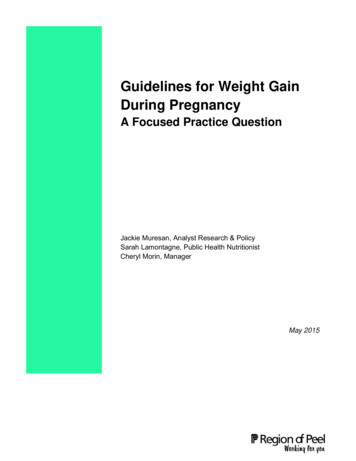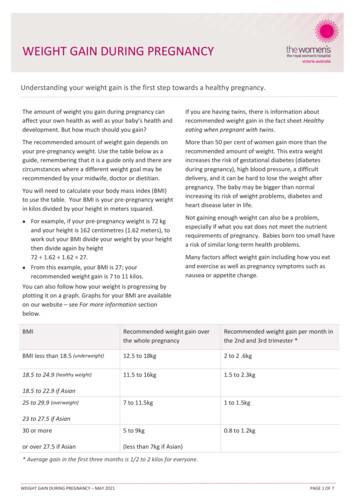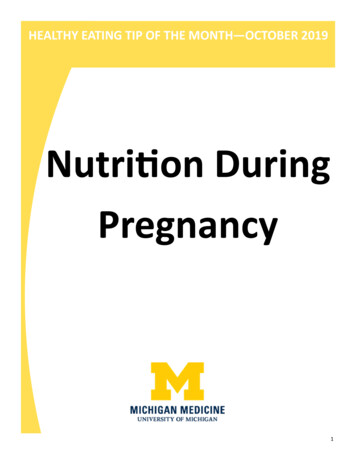
Transcription
Guidelines for Weight GainDuring PregnancyA Focused Practice QuestionJackie Muresan, Analyst Research & PolicySarah Lamontagne, Public Health NutritionistCheryl Morin, ManagerMay 2015
Table of ContentsKey Messages . ii1Issue & Context . 12Literature Review Question . 33Literature Search. 34Relevance Assessment . 35Results of the Search . 46Critical Appraisal. 47Description of Included Studies . 48Synthesis of Findings . 79Recommendations . 9References . 11Appendices . 12Appendix A: Search Strategy . 13Appendix B: Grey Literature Search Flowchart . 15Appendix C: Data Extraction Tables. 16i
Key Messages1. The Institute of Medicine (IOM) has developed a high quality guideline that providesrecommendations on the total amount and rate of weight gain during pregnancy.2. The recommended amount of weight gain during pregnancy is a range that is basedon a woman’s pre-pregnancy body mass index (BMI). These ranges wereestablished based on the weight gain associated with the lowest prevalence ofadverse pregnancy outcomes and are applicable to all women with singletonpregnancies.o For women in the underweight category (BMI 18) prior to pregnancy, 12.518 kg (28-40 lbs) is the recommended weight gain during pregnancy.o For women in the normal weight category (BMI 18.5-24.9) prior to pregnancy,11.5 - 16 kg (25-35 lbs) is the recommended weight gain during pregnancy.o For women in the overweight category (BMI 25.0-29.0) prior to pregnancy, 711.5 kg (15-25 lbs) is the recommended weight gain during pregnancy.o For women in the obese category (BMI 30) prior to pregnancy, 5 - 9 kg (1120 lbs) is the recommended weight gain during pregnancy.3. Provisional guidelines have been developed for gestational weight gain amongwomen carrying multiples.ii
1. Issue & ContextNational data indicate that approximately half of women with a healthy weight when theybecome pregnant gain too much weight during their pregnancy. (1) Among women whoare overweight prior to pregnancy, 68% experience excessive gestational weightgain.(1) Similar trends are observed in Peel for the year 2014 and are being monitoredas the quality of the data improve.(2)The 2014 data for pre-pregnancy body mass index and gestational weight gain arereportable for a subpopulation of 51% of Peel women in the Better Outcomes Registryand Network (BORN). (2) Of these women, 49% were classified as normal weight priorto pregnancy, but almost 35% were overweight or obese. (2) More than half of womenwho were overweight prior to pregnancy gained more weight than recommended. Inaddition, 35% of women with a normal weight exceeded the recommended weight gain(Table 1). (2)A woman’s pre-pregnancy body mass index, as well as the weight she gains duringpregnancy, is associated with adverse outcomes for both the mother and infant. Theseoutcomes of interest may include, but are not limited to, pregnancy inducedhypertension, gestational diabetes, preterm births, caesarean section, infant birthweight,and breastfeeding.Based on available data and the potential impact of unhealthy weight gain on maternaland infant health, the Family Health Division has prioritized the need for pregnantwomen and women of childbearing age to achieve and maintain a healthy body weight.1
Table 1. Maternal Pre-Pregnancy Body Mass Index (BMI) and Maternal WeightGain by Institute of Medicine (IOM) Guideline Recommendations,Peel, 2014Total weight gainby IOM tionAboverecommendationTotal number ofwomenWomen by maternalpre‐pregnancy BMI category (kg/m2)Underweight( alnumber ofwomenObese( 5*Caution should be taken when interpreting data in the figure above. Missing responses are included for the main indicatorpresented. Maternal BMI Category was missing for 10.7% of singleton live birth records in Peel in 2014.Note: In this region, we are able to report on 51% of women who have a pre-pregnancy BMI or gestational weight gain recorded inthe BORN Information System for 2014.BORN’s Maternal Weight Gain Recommended Group variable best aligns with the recommended weight gain ranges outlined withinthe Institute of Medicine’s (IOM) guideline. (4) Mothers who lost weight during their pregnancy were not included in the analysis.Source: Public Health Unit Analytic Reporting Tool (Cube), BORN Information System (BIS), BORN Ontario. Information accessedon February 29, 2016Currently, the Family Health Division’s messaging regarding gestational weight gain isbased on the Prenatal Nutrition Guidelines for Health Professionals from HealthCanada.(3) This guideline from Health Canada is also commonly cited by otherCanadian health agencies. Health Canada’s recommendations for gestational weightgain are adapted from the Institute of Medicine’s (IOM’s) report Weight Gain DuringPregnancy: Re-examining the Guidelines. (4) Given that staff uses the Health Canadaguideline to inform their practice, they need to be aware of the quality of the IOMguideline on which Health Canada’s recommendations are based as well as whetherthey align with other sources.We need to determine optimal weight gain during pregnancy in order to interpret localdata on gestational weight gain and describe the magnitude of the problem in Peel2
Region. In addition, these recommendations may inform public health programmingfocused on healthy weight gain in pregnancy.2. Literature Review QuestionWhat is the recommended amount of weight gain during pregnancy for women in thegeneral population?3. Literature SearchWe conducted a grey literature search of key websites to identify guidelines providingrecommendations about the amount of weight that should be gained during pregnancy.The search included: Turning Research into Practice (TRIP) database, NationalGuideline Clearinghouse, National Institute for Health Care Excellence (NICE), Societyof Obstetricians and Gynaecologists of Canada (SOGC), Health Canada, Public HealthAgency of Canada, Public Health Ontario, Centers for Disease Control and Prevention(CDC), Institute of Medicine, and the World Health Organization. The search wascompleted in November 2015 and is outlined in Appendix A.4. Relevance AssessmentOne reviewer completed the search and screened all titles and abstracts for inclusion.Six potentially relevant guidelines were reviewed in full text. If relevance was stillunclear after full text review, a second reviewer was consulted. Any disagreementswere discussed with a third party. The search results were assessed for relevancebased on the following criteria:3
Inclusion criteria: guideline; English language; published in the last 10years; pregnant women; provision of recommendations regardingamount of weight gain during pregnancy; settings similar to Canada Exclusion criteria: duplicates; focus exclusively on weight managementduring pregnancy5. Results of the SearchTen websites were searched which resulted in 533 titles being screened. Six guidelineswere reviewed in full and two relevant guidelines were identified for inclusion. Refer toAppendix B.6. Critical AppraisalTwo reviewers independently completed the critical appraisal of the two guidelinesusing the AGREE II tool. The two reviewers met to discuss the quality assessmentresults and disagreements were resolved with discussion until consensus was reached.The IOM guideline (4) was rated as high quality. The guideline from SOGC (5) wasrated moderate given that the level of detail provided about the literature review wasinsufficient to determine if the guideline was developed using a systematic process.7. Description of Included StudiesTwo relevant guidelines were included: Institute of Medicine (IOM) and National Research Council (NRC). (2009).Weight gain during pregnancy: Re-examining the guidelines.(4)4
Society of Obstetricians and Gynaecologists of Canada (SOGC). (2010). Clinicalpractice guideline: Obesity in pregnancy.(5)IOM Guideline (2009)The IOM has developed a strong quality guideline that is referred to internationally. Itprovides guidance on the optimal amount and rate of weight gain during pregnancyaccording to a woman’s pre-pregnancy body mass index (BMI). Theserecommendations are a revision of the previous guideline for gestational weight gainreleased by the IOM in 1990. The guideline is intended for use by health careproviders, federal, state and local agencies, medical and public health organizations,as well as private voluntary organizations that have a role in the provision of prenatalcare. The recommendations are intended for women in the United States. Theguideline indicates that although the recommendations may be applicable to womenin other developed countries they should not be used with populations that aresubstantially shorter or thinner than American women or in developing countrieswhere obstetric services are not available.The evidence used to inform this guideline included: a systematic review on theoutcomes of gestational weight gain, a literature review of studies published beforeor after the systematic review, consultation with experts, and four commissioneddata analyses. Some of the key outcomes considered in the systematic reviewincluded: gestational diabetes, hypertensive disorders, preterm birth, caesareandelivery, birthweight, macrosomia, large for gestational age, small for gestationalage, breastfeeding initiation and postpartum weight retention (Refer to Appendix C).5
The evidence included in the systematic review was observational research whichdemonstrated associations between gestational weight gain and specific outcomesof interest; however this research evidence could not be used to establish causalrelationships. For this focused practice question, we concentrated on overallrecommendations for optimal weight gain during pregnancy and did not extract datafrom the systematic review on outcomes associated with weight gain duringpregnancy. Refer to the data extraction tables in Appendix C for further details aboutthis guideline.SOGC unsellingonandmanagement of weight gain in obese pregnant women. It includes guidance onweight gain during pregnancy for women in all BMI categories. The guideline isintended for use by health professionals as well as federal and provincial healthagencies in Canada. The authors conducted a literature review and consultedexperts to develop recommendations; however, the methodology of the guidelinedevelopment is not clearly described. The guideline outlines the impact of obesity inpregnancy on several key outcomes such as spontaneous abortion, hypertensivedisorders of pregnancy, gestational diabetes, macrosomia, shoulder dystocia,caesarean section and thromboembolism. Refer to the data extraction table inAppendix C for further information regarding the SOGC guideline.6
8. Synthesis of Findings The recommended amount of weight that a woman gains during herpregnancy is a range that is based on her pre-pregnancy body mass index(BMI). For women with a normal weight, 11.5 - 16 kg (25-35 lbs) is therecommended weight gain during pregnancy. These ranges are applicable to all women with singleton pregnancies. Provisional guidelines have been developed for gestational weight gainamong women carrying ewprovideweightgainrecommendations specific to a woman’s pre-pregnancy BMI category. These BMIcategories for underweight, normal weight, overweight and obese were developedby the World Health Organization and have been adopted internationally to classifyweight status for all adults.(4) The optimal amount of weight gain during pregnancyis corroborated in the guidelines that were reviewed. However, one minor differenceis that the SOGC guideline advises pregnant women in the obese category (BMI 30.0) to gain 7kg (15 lbs) total (5) and the IOM guideline indicates that obesewomen should gain in the range of 5-9 kg (11-20lbs) total during pregnancy (seeTable 2).7
Table 2. Comparison of recommended maternal weight gain for singleton pregnanciesPre-pregnancy BMIUnderweight 18.5Normal weight18.5-24.9Overweight25.0-29.9Obese 30.0Weight gain range in kgIOMSOGC12.5 - 1812.5 - 1811.5 - 1611.5 - 167 - 11.57 - 11.55-97It is important to note that the amount of weight gain for obese women proposed by theSOGC still falls within the weight-gain range recommended by the IOM.The IOM guideline examined the evidence to determine if specific subgroups may needdifferent weight gain recommendations for pregnancy (e.g. women of short stature,adolescents, racial/ethnic groups, obesity class II and III, parity, and smokers).(4) Therewas no evidence available at the time that this guideline was developed that indicateddifferent gestational recommendations were necessary for particular subpopulations.Based on the IOM’s review of available research, modified guidelines were justified forwomen expecting multiples. (4) Limited evidence indicates that similar to singletonpregnancies, optimal weight gain for women expecting twins varies by pre-pregnancyBMI. The IOM included provisional guidelines for weight gain during pregnancy amongwomen carrying multiple fetuses based on the limited data available (see Table 3). Atthe time that the IOM guideline was developed, no data were available to formulaterecommendations for underweight women expecting twins or for women carrying morethan two fetuses.8
Table 3. Provisional guidelines for maternal weight gain for women with multiples. (4)Pre-pregnancy BMIRecommended total weight gain(kg)Normal weight18.5-24.9Overweight25.0-29.9Obese 30.017 - 2514 - 2311 - 199. RecommendationsGiven that the recommendations for optimal weight gain during pregnancy areconsistent, it is recommended that the Family Health Division:1. Use the IOM guideline to interpret local data and determine if there is a problem ofexcessive gestational weight gain in Peel Region and monitor this data on anongoing basis to observe trends over time.2. Refer to the IOM guidelines when developing or revising Peel Public Healthresources that provide information about healthy weight gain during pregnancy.3. Inform Family Health staff of the purpose, findings and recommendations from thisevidence review by way of written advisory given that a significant change in practiceis not required.4. Share the findings of this evidence review with BORN. There is a lack of clarity in theBORN data dictionary about which guideline was used to calculate the proportion ghtgainrecommendations. Exploratory analyses were performed to determine the weightgain recommendations used. The results of this evidence review and exploratory9
analyses should be shared with BORN to clarify which guideline is being used todetermine appropriate weight gain and to recommend that the guideline used shouldbe included in future data dictionary release.5. Determine if it is necessary to review additional research evidence: i) to understandthe effect of the current IOM guidelines on maternal and child health outcomes fromstudies published after 2009 when the IOM guideline was last updated and ii) toidentify effective public health interventions to promote optimal weight gain amongpregnant women that are applicable to Peel Region.10
References1) Public Health Agency of Canada. What mothers say: The Canadian maternityexperiences survey. Ottawa, 2009.2) Public Health Unit Analytic Reporting Tool (Cube). BORN Information System (BIS),BORN Ontario. Information accessed on February 29, 2016.3) Health Canada. Prenatal nutrition guidelines for health professionals: Gestationalweight gain [Internet]. Ottawa: Health Canada; 2010. Available from: http://www.hcsc.gc.ca/fn-an/alt formats/pdf/nutrition/prenatal/ewba-mbsa-eng.pdf4) Institute of Medicine (IOM) and National Research Council (NRC). Weight gainduring pregnancy: Re-examining the guidelines. Washington, DC: The NationalAcademies Press; 2009. Available idelines.aspx5) Society of Obstetricians and Gynaecologists. Clinical practice guideline: Obesity inpregnancy. J Obstet Gynaecol Can. 2010 Feb; 32(2):165-73. [Internet] Availablefrom: CPG1002.pdf6) Viswanathan M, Siega-Riz AM, Moos MK, Deierlein A, Mumford S, Knaack J,Thieda P, Lux LJ, Lohr, KN. (2008) Outcomes of maternal weight gain. Evidencereport/Technology assessment number. 168. Rockville, MD: Agency of HealthcareResearch and Quality (AHRQ).11
AppendicesAppendix A: Search StrategyAppendix B: Grey Literature Search FlowchartAppendix C: Data Extraction Tables12
Appendix A: Search StrategySearches conducted in November 2015DatabaseSearch TermsResults(“gestational weight gain”), limit to guidelines10("gestational" OR "pregnan*") AND ("weight gain"), limit to guidelines2481. TRIP2. National GuidelineClearinghouse3. NICEAlso tried:("gestational" OR "pregnan*") AND ("weight”), limit to guidelines – TOO MANYHITS (1,096) – first 50 not relevant therefore this search string was not used.n/a(“gestational weight gain”)36("gestational" OR "pregnan*") AND ("weight”)(“gestational weight gain”)1082(1 duplicate) 30(“gestational weight gain”) AND (“guideline*”)("gestational" OR "pregnan*") AND ("weight”) 30Exact # of hits notprovided – reviewedfirst two pages ofresults for eachsearch and foundnone relevant9(1 duplicate)4. CDC5. Society of Obstetriciansand Gynaecologists ofCanada6. Health Canada“weight”Site had primitive search functionsAlso scanned all titles of clinical practice guidelines(“gestational weight gain”)13("gestational" OR "pregnan*") AND ("weight”)913
7. Public Health Agency ofCanada8. Public Health Ontario9. World HealthOrganization10. Institute of Medicine(“gestational weight gain”)7("gestational" OR "pregnan*") AND ("weight”)(“gestational weight gain”)18("gestational" OR "pregnan*") AND ("weight”)(“gestational weight gain”)012("gestational" OR "pregnan*") AND ("weight”)(“gestational weight gain”)10533TOTAL14
Appendix B: Grey Literature Search FlowchartPHO (8)(258)TRIP (348)PHAC (8)NICE (2)NGC (144)CDC (60)SOGC (9)Health Canada(22) WHO (12)IOM (10)Total identified articles (533)Removal of DuplicatesPrimary Relevance Assessment (527)Non-relevant (based on titleand abstract screening) (521)Relevance assessment of full document versionsNon-relevant articles (4)Total Relevant Guidelines (2)Quality assessment of relevant articles (2)Strong guideline (1)Moderate guideline (1)15
Appendix C: Data Extraction TablesData Extraction for GuidelinesLast revised: 2016-02-07Guideline #1Weight Gain During Pregnancy: Re-examining the theGuidelines.aspxAuthors, Date, CountryQuality AssessmentGeneralizabilityDetails of the GuidelineFocus & Objective(s)Target AudienceEvidence Used to Developthe GuidelineInstitute of Medicine, 2009United States of AmericaRated 6/7 (strong) and recommended for use by two independentappraisers (JM & SL) using AGREE II tool.The critical appraisal revealed that the editorial independence of theguideline developers is not discussed and a schedule for updating theguideline is not provided.These guidelines are intended for use among women in the United States.They may be applicable to women in other developed countries howeverthey are not intended for use in areas of the world where women aresubstantially shorter or thinner than American women or where adequateobstetric services are unavailable. (p. 242)To review evidence on the relationship between weight gain patternsbefore, during and after pregnancy and maternal and child healthoutcomes and recommend revisions to existing guidelines wherenecessary.Health care providers, those who provide prenatal care, federal, state andlocal agencies, private voluntary organizations, medical and public healthorganizations. Systematic review of outcomes of gestational weight gain (6) Literature review (of studies published before or after the date limitsused for the systematic review). Consultation with experts Four additional data analyses commissioned by the guidelinedevelopers:i.ii.iii.iv.Analyses from the Danish National Birth Cohort on low and very highcategories of gestational weight gain (GWG), as well as data for obeseclass I, II and III women and subgroups pregnant women, such asprimiparous, short and young women, and smokers.Analysis of data from the 1988 National Maternal and Infant HealthSurvey (NMIHS) on the association between GWG and pregnancyoutcomes by race and on the association between GWG and postpartumweight retention.Data on adverse outcomes associated with GWG stratified by racial/ethnicgroup using births data from 1995-2003 in New York City.Quantitative analysis of risk trade-offs between maternal and child healthoutcomes associated with GWG.16
Overall RelevantRecommendations from theGuidelineNote: Only recommendationsthat answered the focusedpractice question wereextractedRanges of optimal gestational weight gain for each pre-pregnancy BMIcategory are based on EXPERT CONSENSUS informed by a systematicanalysis of the sources of evidence listed above.Recommended ranges were formulated based on the gestational weightgain values associated with the lowest prevalence of the most significantmaternal and infant outcomes of weight gain in pregnancy based onfindings from the review of evidence. These key outcomes included: i)caesarean delivery, 2) postpartum weight retention, 3) preterm birth, 4)small or large for gestational age, and 5) childhood obesity.For each category of pre-pregnancy BMI, the guideline developmentcommittee considered:o Incidence or prevalence of each of the key outcomeso Whether the outcomes were permanent or potentiallymodifiableo The quality of available datao Risk analysiso Acceptability by clinicians and clientsRecommended weight gain for singleton pregnancies:Total and rate of weight gain during pregnancy, by pre-pregnancyBMITotal weight gainPre-pregnancyBMIRange inkgRange inlbsUnderweight 18.5 kg/m212.5-1828-40Normal weight18.5-24.9 kg/m211.5-1625-35Overweight25.0-29.9 kg/ m27-11.515-25Obese 30.0 kg/ m25-911-20Rates of weight gain*2nd & 3rd trimesterMeanMean(range) in(range) 0.4-0.6)0.27)*Calculations assumed a 0.5-2 kg (1.1-4.4 lbs) weight gain in the first trimester(based on Siega-Riz et al., 1994; Abrams et al., 1995; Carmichael et al., 1997)17
Provisional guidelines for gestational weight gain for women withmultiple fetusesPre-pregnancy BMIRecommended total weight gainkglbsNormal 29.9Obese11-1925-42 30.0“Data sources do not provide sufficient information to develop provisionalguidelines for underweight women. These provisional guidelines reflect theinterquartile (25th-75th) range among women who delivered their twin, whoweighed 2,500g on average, at 37-42 weeks gestation.” p. 252Comments/LimitationsThe observational studies used to inform this guideline demonstraterelationships between GWG and specific outcomes; however theseassociations do not demonstrate causal relationships.In addition it should be noted that this guideline has not been updated andthe guideline authors do not provide a plan to review and/or update theguideline.NOTE: The following outlines the methods of the systematic review and literature review that wereconducted to inform this guideline. The information below does not include details of the consultation withexperts or additional data analyses.Details of the systematic review(6) and literature reviewFocus of the systematic1. Systematic reviewreview and literature review Outcomes of gestational weight gain with specific attention to:that informed this guidelineo Weight gain during pregnancy and association with i) birthoutcomes, ii) infant health outcomes, and iii) maternal healthoutcome and their confounders and effect modifiers.o Gestational weight gain within or outside the 1990 Institute ofMedicine (IOM) guidelines for weight gain during pregnancy.o Risks and benefits of weight gain recommendations for pregnantwomen.o Anthropometric measure of weight gain in pregnancy.2. Literature review Consequences of gestational weight gain for the mother and infantdescribed in literature published before and after the date limits usedfor the systematic review.Date of Search1. 1990-October 20072. Before 1990, after October 2007 until 2009Databases Searched1. Systematic review MEDLINE, Cochrane Collaboration, CINAHL, Embase. Hand-searched reference lists of relevant articles and consulted withexperts to identify any additional studies or any research underwayand not yet published.2. Medline, Science Direct, WorldCat/First Search18
Inclusion and ExclusionCriteriaSystematic review & literature review:Inclusion: women of any age with singleton pregnancies, pre-pregnancybody mass index (BMI) or weight must be accounted for in relationshipbetween maternal weight gain and outcome, studies conducted indeveloped nations: United States, Canada, Western Europe, Japan,Australia, New Zealand, publication after 1990 (when last guidelines forGWG were released),English language, Study designs: Systematicreviews, meta-analyses, Controlled trials (n 40), nonrandomizedcontrolled trials (n 40), prospective trials with historical controls (n 40),prospective or retrospective observational cohort studies (n 40), andmedium to large case series (n 100)Exclusion: studies with a small sample size (case series 100 and cohorts 40), studies that failed to control for pregravid weight, studies limited towomen with pre-existing health conditionsNumber of StudiesTypes of Studies includedOutcomes Included1. Systematic review 150 studies2. Literature review 33 additional studies not included in the systematic reviewSystematic review & literature review RCTs, Prospective cohort, retrospective cohort and case-controlstudiesMaternal outcomesAntepartum period: abnormal glucose metabolism and gestationaldiabetes, maternal discomforts in pregnancy, hyperemesis, hypertensivedisorders, gallstones.Intrapartum period: premature rupture of membranes, preterm labour,postterm pregnancy, induction of labour, length of labour, mode ofdelivery, vaginal birth after caesarean, vaginal lacerations, shoulderdystocia, cephalopelvic disproportion, complications of labour and delivery.Postpartum period: lactation, weight retention, premenopausal breastcancer, postpartum depression and maternal mortality.Birth outcomes: preterm birth, birthweight, low birthweight, macrosomia,large for gestational age, small for gestational age, apgar scores.Infant outcomes: perinatal mortality, birth defects, breastfeeding initiationand maintenance, neonatal hypoglycemia, neonatal distress,hyperbilirubinemia, neonatal hospitalization, other infant morbidity, infantBMI, infant growth, childhood weight status, childhood hospitalizations.19
Data Extraction for GuidelinesLast revised: 2016-02-07Guideline #2Clinical Practice Guideline: Obesity in 1/gui239ECPG1002.pdfAuthors, Date, CountrySociety of Obstetricians and Gynaecologists of Canada (SOGC), 2010CanadaQuality AssessmentRated 4/7 (moderate) by two appraisers (JM & SL) using AGREE II tool.GeneralizabilityIntended for obese pregnant women in CanadaDetails of the GuidelineFocus & Objective(s)To review the evidence and provide recommendations for the counsellingand management of obese parturients.Target AudienceHealthcare professionalsEvidence Used to Develop Literature reviewthe GuidelineOverall RelevantRecommendations from thePregnancy weight gain based on BMIGuidelineBMI rangeSuggested weight gain(kg)Note: Only recommendationsUnderweight 18.512.5-18that answered the focusedNormal weight18.5-24.911.5-16practice question wereOverweight25.0-29.97-11.5extractedObese class I30.0-34.97Obese class II35.0-39.97Obese class III 40.07EXPERT CONSENSUSComments/LimitationsThe guideline authors do not provide details about the studies included inthe literature review, process for determining what evidence wasincluded/excluded, quality assessment, data extraction, or how the specificrecommendations for optimal weight gain were determined. Theinf
11.5 kg (15-25 lbs) is the recommended weight gain during pregnancy. o For women in the obese category (BMI 30) prior to pregnancy, 5 - 9 kg (11-20 lbs) is the recommended weight gain during pregnancy. 3. Provisional guidelines have been developed for gestational weight gain among women carrying multiples.










